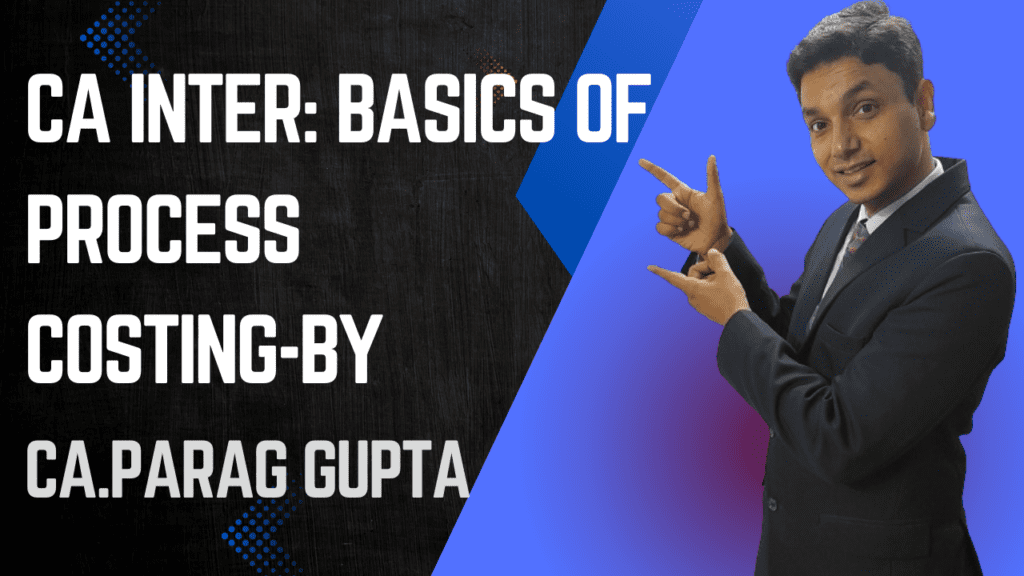CA Inter Process costing is a fundamental concept in managerial accounting, especially for businesses involved in manufacturing or producing goods. This method provides a structured approach to allocate costs to products in a manufacturing environment where goods are produced in a continuous process. In this blog, we delve into the basics of process costing, as elucidated by CA Parag Gupta.
What is Process Costing?
Process costing is a method used to determine the cost of producing a product by assigning costs to each stage of the production process. Unlike job costing, where costs are assigned to each individual job, process costing is suitable for continuous production processes where products are identical or similar.
Key Elements of Process Costing:
1. Cost Accumulation:
Process costing involves accumulating costs in various production departments or processes. These costs typically include direct materials, direct labor, and manufacturing overhead.
2. Cost Allocation:
Once costs are accumulated, they are allocated to units produced during a specific period. The total cost incurred in each department is divided by the number of units produced to determine the cost per unit.
3. Equivalent Units:
In process costing, not all units in production are completed at the same time. Therefore, equivalent units are calculated to determine the equivalent amount of work done on partially completed units. This helps in accurately allocating costs to units at different stages of completion.
4. Cost Per Equivalent Unit:
After calculating equivalent units, the total cost incurred in a department is divided by the equivalent units to determine the cost per equivalent unit. This cost is then used to assign costs to units completed and transferred out, as well as units still in process.
5. Cost Reconciliation:
At the end of a reporting period, costs from different departments or processes are reconciled to ensure accuracy. Any differences in costs are adjusted to maintain consistency in cost allocation.
Process Costing Explained
Process costing is a managerial accounting method used to determine the cost of producing a product in a continuous production environment. It involves accumulating costs in various production departments or processes, including direct materials, direct labor, and manufacturing overhead. These costs are then allocated to units produced during a specific period based on the number of units completed or their stage of completion. Equivalent units are calculated to account for partially completed units, allowing for accurate cost allocation. The cost per equivalent unit is determined by dividing the total cost incurred in a department by the equivalent units. Finally, costs from different departments are reconciled to ensure accuracy. Process costing offers simplicity and efficiency in cost allocation, making it suitable for industries with standardized production processes like food and beverage, chemicals, and textiles. It enables businesses to estimate costs accurately, control costs, and evaluate departmental performance for informed decision-making.
When to use Process Costing ?
Process costing is used for several reasons, making it a valuable tool in managerial accounting for industries with continuous production processes:
- Cost Allocation in Continuous Production: Process costing is ideal for industries where goods are produced continuously, such as chemical manufacturing or food processing. It accurately allocates costs to each stage of production, ensuring that the cost of each unit reflects the resources consumed.
- Simplicity and Efficiency: Compared to other costing methods like job costing, process costing is simpler and more efficient. It streamlines cost allocation by focusing on the production process rather than individual jobs or units, reducing administrative burden and time.
- Accurate Cost Estimation: Process costing provides a clear understanding of the cost of production, allowing businesses to estimate costs accurately for pricing decisions, budgeting, and financial reporting purposes. This enables companies to set competitive prices while maintaining profitability.
- Cost Control: By tracking costs at each stage of production, process costing helps identify areas where costs can be reduced or eliminated. This facilitates cost control measures, such as optimizing resource utilization, improving efficiency, and minimizing wastage.
- Performance Evaluation: Process costing enables management to evaluate departmental performance by comparing actual costs with standard costs. It helps identify areas of inefficiency or deviation from expected costs, enabling corrective actions to be taken to improve overall performance.
Also read another blog on CA Inter Process Costing:
Avoid these 5 Mistakes in CA Inter Process Costing I By Parag Gupta sir
CA Inter Costing May 24 suggested answer on Process Costing
Advantages of Process Costing:
- Simplicity: Process costing is relatively simpler compared to other costing methods, making it suitable for industries with standardized production processes.
- Cost Control: By tracking costs at each stage of production, process costing helps identify areas where costs can be reduced or eliminated, thereby enhancing cost control.
- Cost Estimation: Process costing provides valuable insights into the cost of production, enabling businesses to estimate costs accurately for pricing decisions and budgeting purposes.
- Performance Evaluation: It facilitates the evaluation of departmental performance by comparing actual costs with standard costs, helping management make informed decisions to improve efficiency.
Conclusion
Process costing, as elucidated by experts like CA Parag Gupta, is a vital tool for businesses engaged in manufacturing processes. By systematically allocating costs to each stage of production, process costing provides valuable insights into the cost of production, facilitates cost control, and aids in performance evaluation. With its widespread applications across industries, understanding the basics of process costing is essential for effective managerial decision-making and financial management in manufacturing businesses.
FAQ’S
The majority of individuals concur that auditing is the most challenging CA Intermediate subject. For many students, independent study is challenging and competitive.
Yes and no. If you are a first-timer and you have only 3 months in hand, you should attempt only one group. But, if you’re planning to attempt both groups, 3 months won’t be sufficient.
More specifically, process costing is important because it helps companies: Control inventory numbers and be able to distribute accurately. Monitor profits to know precisely how much they are spending and earning. Report numbers from each department uniformly and accurately.
Group 2’s subjects can be thought of as simpler than Group 1’s. More practical courses, including accounting, taxation, and costing, are covered in Group 1. If one enjoys answering practical problems, Group 1 can be simpler.
You can manage to clear CA inter exams through self-study. To do that, you will need a solid routine and strict discipline to stick to it. While ICAI material, previous years’ papers, and RTP are good enough, most students benefit from specialized CA inter coaching classes, especially the mock tests.





